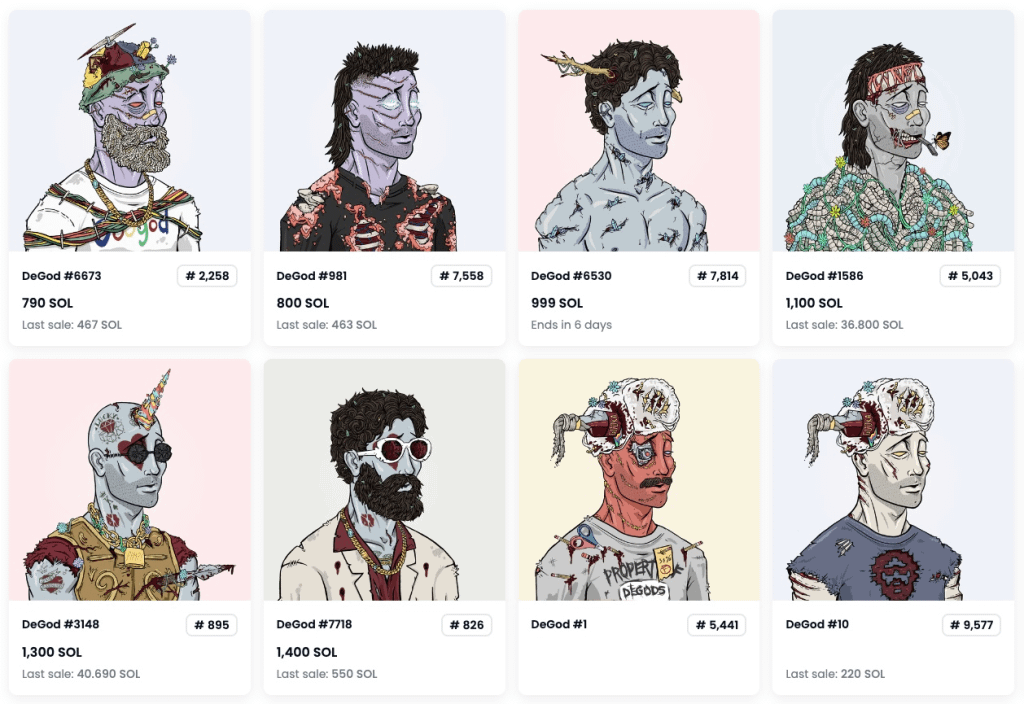DeGods NFTs have made their way to the Bitcoin blockchain. Discover why this cryptocurrency revolution gains traction
Non-fungible token (NFT) enthusiasts have been buzzing over Bitcoin’s first NFT project, Ordinals. Consequently, more than 100,00 NFTs have joined the blockchain network in barely two weeks — 535 of which are DeGods, Solana’s most significant project.
Quick Take:
- More than 100,00 NFTs have joined Bitcoin in under two weeks.
- 535 of those NFTs are Solana’s most significant project, DeGods.
- DeGods CEO, Frank, moved NFTs to Bitcoin because of being a long-term fan of the network.
- Moreover, Frank believes a presence among all chains is essential.
- To prevent steep gas fees, Luxor Technologies assisted DeGods with renewable energy solutions.

Why 535 DeGods NFTs Move to Bitcoin
The 535 DeGods now available on Bitcoin were initially launched on Solana in 2021. However, they were “burned”, therefore, permanently destroyed to lower the project’s supply in its early days.
On Monday, DeGods announced the digital assets’ new lease of life on Twitter:
One of the main reasons for this new beginning is that Frank firmly believes that presence on all chains is essential. Hence, DeGods broader project is bridging from Solana to Ethereum this quarter. And his sister project, y00ts, is currently bridging from Solana to Polygon.
Technicalities Behind Joining Bitcoin
Ordinals have a new method of creating NFT-like media and assets on the Bitcoin blockchain. First, the project connects the assets to a single Satoshi (equivalent to 1/100,000,000th of one BTC). Then, it stores them on the blockchain as being transferable.
The NFT project has quickly spawned clones of CryptoPunks and playable Web3 games on Bitcoin. OnChain Monkey, an Ethereum project, also inscribed its entire original collection of 10,000 NFTs in a single instance.
Nevertheless, Ordinals is facing significant opposition from Bitcoin maximalists for contributing to network congestion and increased gas fees for transactions. There is a significant need for more infrastructure and platforms to make this process easier to handle and transact.
Luckily, having an awareness of these issues, DeGods did not mint its NFTs in the same ways nor spread inscriptions across multiple Bitcoin blocks — despite jumping on board almost instantly.
The team behind DeGods joined forces with Bitcoin miner Luxor Technologies for all NFT inscriptions to etch onto the blockchain as a single, exclusive block. All of this was achievable via a carbon-neutral mining pool powered by renewable energy solutions processed by DMG Blockchain Solutions’ Terra Pool.
To achieve such goals, the team behind DeGods did have to compress the 535 images to 210×210 pixels to fit into a single Bitcoin block.
But once conserving space — and tributing to Bitcoin’s supply of 21M BTC — the OG NFTs are now permanently on the blockchain network for safekeeping and re-use.
These assets will now forever live on the Bitcoin blockchain under Ordinals, alongside many others to come.
Subscribe to the NFT Lately newsletter to receive news covering the latest NFT-related drops, releases, reviews, and more.



